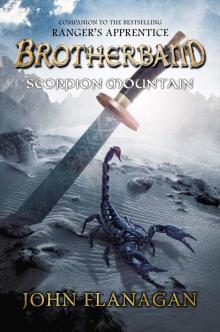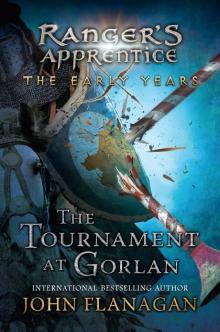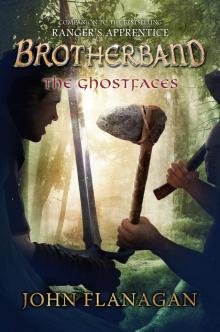- Home
- John A. Flanagan
The Ghostfaces
The Ghostfaces Read online
Also by John Flanagan
BROTHERBAND CHRONICLES
Book 1: The Outcasts
Book 2: The Invaders
Book 3: The Hunters
Book 4: Slaves of Socorro
Book 5: Scorpion Mountain
THE RANGER’S APPRENTICE EPIC
Book 1: The Ruins of Gorlan
Book 2: The Burning Bridge
Book 3: The Icebound Land
Book 4: The Battle for Skandia
Book 5: The Sorcerer of the North
Book 6: The Siege of Macindaw
Book 7: Erak’s Ransom
Book 8: The Kings of Clonmel
Book 9: Halt’s Peril
Book 10: The Emperor of Nihon-Ja
Book 11: The Lost Stories
Book 12: The Royal Ranger
RANGER’S APPRENTICE: THE EARLY YEARS
The Tournament at Gorlan
PHILOMEL BOOKS
an imprint of Penguin Random House LLC
375 Hudson Street, New York, NY 10014
Copyright © 2016 by John Flanagan. First published in Australia by Random House Australia in 2016.
Map copyright © by Mathematics and Anna Warren.
Penguin supports copyright. Copyright fuels creativity, encourages diverse voices, promotes free speech, and creates a vibrant culture. Thank you for buying an authorized edition of this book and for complying with copyright laws by not reproducing, scanning, or distributing any part of it in any form without permission. You are supporting writers and allowing Penguin to continue to publish books for every reader.
Philomel Books is a registered trademark of Penguin Random House LLC.
eBook ISBN 9780698174597
Library of Congress Cataloging-in-Publication Data is available upon request.
U.S. edition edited by Michael Green.
This is a work of fiction. Names, characters, places, and incidents either are the product of the author’s imagination or are used fictitiously, and any resemblance to actual persons, living or dead, businesses, companies, events, or locales is entirely coincidental.
Version_1
Contents
Also by John Flanagan
Map
Copyright
A Few Sailing Terms Explained
Title Page
PART ONE: THE STORM
chapter one
chapter two
chapter three
chapter four
chapter five
chapter six
chapter seven
chapter eight
chapter nine
PART TWO: THE BEAR
chapter ten
chapter eleven
chapter twelve
chapter thirteen
chapter fourteen
chapter fifteen
chapter sixteen
chapter seventeen
chapter eighteen
chapter nineteen
chapter twenty
chapter twenty-one
PART THREE: THE MAWAGANSETT
chapter twenty-two
chapter twenty-three
chapter twenty-four
chapter twenty-five
chapter twenty-six
chapter twenty-seven
chapter twenty-eight
chapter twenty-nine
chapter thirty
chapter thirty-one
PART FOUR: THE GHOSTFACES
chapter thirty-two
chapter thirty-three
chapter thirty-four
chapter thirty-five
chapter thirty-six
chapter thirty-seven
chapter thirty-eight
chapter thirty-nine
chapter forty
chapter forty-one
chapter forty-two
chapter forty-three
chapter forty-four
Epilogue
Author’s Note
About the Author
A Few Sailing Terms Explained
Because this book involves sailing ships, I thought it might be useful to explain a few of the nautical terms found in the story.
Be reassured that I haven’t gone overboard (to keep up the nautical allusion) with technical details in the book, and even if you’re not familiar with sailing, I’m sure you’ll understand what’s going on. But a certain amount of sailing terminology is necessary for the story to feel realistic.
So, here we go, in no particular order:
Bow: The front of the ship, also called the prow.
Stern: The rear of the ship.
Port and starboard: The left and the right side of the ship, as you’re facing the bow. In fact, I’m probably incorrect in using the term port. The early term for port was larboard, but I thought we’d all get confused if I used that.
Starboard is a corruption of “steering board” (or steering side). The steering oar was always placed on the right-hand side of the ship at the stern.
Consequently, when a ship came into port, it would moor with the left side against the jetty, to avoid damage to the steering oar. One theory says the word derived from the ship’s being in port—left side to the jetty. I suspect, however, that it might have come from the fact that the entry port, by which crew and passengers boarded, was also always on the left side.
How do you remember which side is which? Easy. Port and left both have four letters.
Forward: Toward the bow.
Aft: Toward the stern.
Fore-and-aft rig: A sail plan in which the sail is in line with the hull of the ship.
Hull: The body of the ship.
Keel: The spine of the ship.
Stem: The upright timber piece at the bow, joining the two sides together.
Forefoot: The lowest point of the bow, where the keel and the stem of the ship meet.
Steering oar: The blade used to control the ship’s direction, mounted on the starboard side of the ship, at the stern.
Tiller: The handle for the steering oar.
Sea anchor: A method of slowing a ship’s downwind drift, often by use of a canvas drogue—a long, conical tube of canvas closed at one end and held open at the other—or two spars lashed together in a cross. The sea anchor is streamed from the bow and the resultant drag slows the ship’s movement through the water.
Yardarm, or yard: A spar (wooden pole) that is hoisted up the mast, carrying the sail.
Masthead: The top of the mast.
Bulwark: The part of the ship’s side above the deck.
Scuppers: Drain holes in the bulwarks set at deck level to allow water that comes on board to drain away.
Belaying pins: Wooden pins used to fasten rope.
Oarlock, or rowlock: Pegs set on either side of an oar to keep it in place while rowing.
Thwart: A seat.
Telltale: A pennant that indicates the wind’s direction.
Tacking: To tack is to change direction from one side to the other, passing through the eye of the wind.
If the wind is from the north and you want to sail northeast, you would perform one tack so that you are heading northeast, and you would continue to sail on that tack for as long as you need.
However, if the wind is from the north and you want to sail due north, you would have to do so in a series of short tacks, going back and forth on a zigzag course, crossing through the wind each time, and slowly making grou
nd to the north. This is a process known as beating into the wind.
Wearing: When a ship tacks, it turns into the wind to change direction. When it wears, it turns away from the wind, traveling in a much larger arc, with the wind in the sail, driving the ship around throughout the maneuver. Wearing was a safer way of changing direction for wolfships than beating into the wind.
Reach, or reaching: When the wind is from the side of the ship, the ship is sailing on a reach, or reaching.
Running: When the wind is from the stern, the ship is running. (So would you if the wind was strong enough at your back.)
Reef: To gather in part of the sail and bundle it against the yardarm to reduce the sail area. This is done in high winds to protect the sail and the mast.
Trim: To adjust the sail to the most efficient angle.
Halyard: A rope used to haul the yard up the mast. (Haul-yard, get it?)
Stay: A heavy rope that supports the mast. The backstay and the forestay are heavy ropes running from the top of the mast to the stern and the bow (it’s pretty obvious which is which).
Sheets and shrouds: Many people think these are sails, which is a logical assumption. But in fact, they’re ropes. Shrouds are thick ropes that run from the top of the mast to the side of the ship, supporting the mast. Sheets are the ropes used to control, or trim, the sail—to haul it in and out according to the wind strength and direction. In an emergency, the order might be given to “let fly the sheets!” The sheets would be released, letting the sail loose and bringing the ship to a halt. (If you were to let fly the sheets, you’d probably fall out of bed.)
Hawser: Heavy rope used to moor a ship.
Way: The motion of the ship. If a ship is under way, it is moving according to its course. If it is making leeway, the ship is moving downwind so it loses ground or goes off course.
Lee: The downwind side of a ship, opposite to the direction of the wind.
Lee shore: A shoreline downwind of the ship, with the wind blowing the ship toward the shore—a dangerous situation for a sailing ship.
Back water: To row a reverse stroke.
So, now that you know all you need to know about sailing terms, welcome aboard the world of the Brotherband Chronicles!
John Flanagan
PART ONE
THE STORM
chapter one
I don’t like the look of that,” Thorn said, wrinkling his nose as he sniffed the damp salt air.
He and Hal were standing on the breakwater of the small harbor that served Castle Dun Kilty in Clonmel. The castle itself was several kilometers inland, but the harbor was home to a small fishing fleet that provided food for the castle and its surrounding village. In addition, it was a haven for courier ships bringing messages to King Sean, ruler of Clonmel.
Heron was one such ship. She had delivered a signed and sealed set of official papers to the king, a renewal of the treaty between Skandia and Clonmel. She had also delivered similar documents to three other kingdoms farther down the Hibernian coast. Erak liked to use the Heron for such tasks. She was fast and handy, and Hal was a reliable navigator.
Now, however, their task was completed and it was time to head for home. But the weather wasn’t altogether promising.
The two friends studied the gray, racing seas that surged past outside the harbor walls, driven by the stiff north wind.
Thorn sniffed again. “It’ll be a wet, rough passage north to round the tip of Picta,” he said.
Hal shrugged. “We’ve been wet before,” he replied, and then grinned. “It’s part of a sailor’s lot, they say.”
“No sense in getting soaked for the sake of it,” Thorn said. “If we wait a day or two, this might blow itself out.”
“Or it might get worse, and then we’ll find ourselves trapped here, with a hard beat north into the wind and sea. We could be caught here for a week or more.”
“We’d be dry,” Thorn said.
Hal shook his head. “We’d be bored to tears as well,” he said. “There’s precious little to do in the town here.” He paused, studying the racing waves once more, looking to the north, then came to a decision. “We’ll go,” he said. “Let’s get the crew on board.”
They strode briskly back around the breakwater to the small town. There was an inn there where the Herons had been accommodated while they carried out their diplomatic mission. The others were finishing their breakfasts in the taproom when Hal and Thorn entered, allowing a gust of cold wind to swirl around the room and set the fire flaring in the grate. Eight pairs of eyes looked up at them expectantly.
“We’re going,” Hal told them.
“About time too,” Stig said. He shared Hal’s opinion of the lack of entertainment in the little port. Stefan, Ulf and Wulf gulped down the rest of the nourishing porridge the innkeeper had served them. The rest of the crew had finished eating, but they took final sips of the inn’s excellent coffee, knowing it would be their last for some time.
Hal glanced at Edvin. “Are we stocked up?”
Edvin nodded. “Provisioned and watered, ready to go,” he said, then added, “Although I’d like to pick up a few loaves of bread.”
Once they were at sea, they’d be subsisting on hardtack biscuits. It was always good to have a supply of soft fresh bread at the start of the voyage. Hal nodded assent and Edvin hurried out, heading for the bakery a few doors away. The rest of the crew gathered up their rucksacks and other personal belongings and straggled out the door.
“Take a reef in the sails before you hoist them,” Hal called after Ulf and Wulf. “That wind is getting up.”
The two sail trimmers nodded. It made sense to do this before they hoisted the sails, rather than have to lower them again to lash a fold in them and reduce the sail area.
Hal waited behind to check the reckoning the innkeeper had ready for him. He ran his finger down the list of charges—so many rooms for so many nights, and a tally of the meals his crew had eaten. He signed off on the bill and handed it back. They were on a diplomatic mission and the bill would be sent to Castle Dun Kilty.
“Thanks for the hospitality,” he said to the innkeeper.
“Always a pleasure to see you,” the innkeeper replied. The Herons had provided him with good business at a slack time of the year. Then he couldn’t help grinning. “Although there was a time I’d never have said that to Skandians.”
Hal smiled in return. Not too many years ago, the presence of a wolfship in the harbor would have been accompanied by a lot of unpleasantness, and the skirl wouldn’t have been signing for the food and drink consumed by the crew. He would have simply seized it at sword point—along with the inn’s taking for the week.
“Different times,” he said. He picked up his own kit bag from where he had left it earlier in the morning and tossed it over his shoulder as he exited. The cold wind whistled round the harbor, and he quickened his pace as he headed for the jetty where Heron was moored.
Edvin was a few meters in front of him, carrying a net of fresh loaves. He jumped lightly down from the jetty onto Heron and stowed the bread in the central watertight section of the hull. Even inside the bay, the unruly sea was causing the little ship to jerk at her moorings and setting the wicker fenders squealing as she snubbed against the ropes holding her to the jetty.
Hal made his way aft, stowed his kit bag in his personal space and stepped to the steering platform. He glanced at Stig.
“All ready?” he asked, although he knew the answer. Stig was an efficient first mate.
“Whenever you are,” Stig replied.
Hal unlashed the restraining rope on the tiller and looked around the harbor. There were no other ships moving. The boats of the little fishing fleet were cozily tucked up in their moorings farther down harbor.
Very wise of them, he thought bleakly, pulling his sheepskin collar up higher round his neck in anticipati
on of the wet journey ahead. He reached inside his jerkin and produced his woolen watch cap, emblazoned with the heron symbol. He pulled it tight down round his ears and glanced up at the wind telltale on the mast. The wind was on their beam, from the port side.
“Starboard sail,” he ordered, and Stefan and Jesper bent to the halyards, sending the slender, curving yardarm up the mast and letting it clunk into place. Ulf and Wulf were watching him expectantly.
“Cast off for’ard!” Hal called to Thorn in the bow. Thorn released the for’ard mooring rope and the bow began to swing out, away from the jetty.
“Cast off aft,” he said to Stig, then, “Sheet home!”
The ship gathered way almost immediately as the twins hauled the sail tight. She curved away from the jetty, buffeting her way through the short, steep waves. Hal let her slide away to starboard, heading diagonally across the little bay. The tiller vibrated under his hand, and, as ever, he marveled at the sense that he was in control of a living being.
When he judged the angle was right, he brought the bow round to port and the twins reacted immediately, hauling the sail in tighter. Now Heron was angled to the left of the harbor mouth. But she’d make leeway, falling off to the right under the force of the wind, so that when they reached the harbor mouth, she’d be heading straight for the center of the gap. Hal couldn’t have articulated how he knew where to head the bow so they would arrive at that exit point. It was a combination of instinct and experience, and his intimate knowledge of his ship’s performance and handling.
The ship passed between the two granite breakwaters, heading into the open sea. Instantly, the wind force increased as they emerged from the shelter of the harbor, and the ship began to heel to starboard. Ulf and Wulf, without needing to be told, eased the sheets to reduce the pressure in the sail, and the Heron came upright once more. She rose to the first of the rollers, then slid down into the trough behind it, smashing into the following wave and drenching the deck and its occupants with a shower of white water.
“What price a warm, dry inn now?” Thorn called.
Hal grinned at him. “I can set you ashore again if you like,” he said. “We’ll come back for you next summer.”

 Scorpion Mountain
Scorpion Mountain The Tournament at Gorlan
The Tournament at Gorlan The Ghostfaces
The Ghostfaces